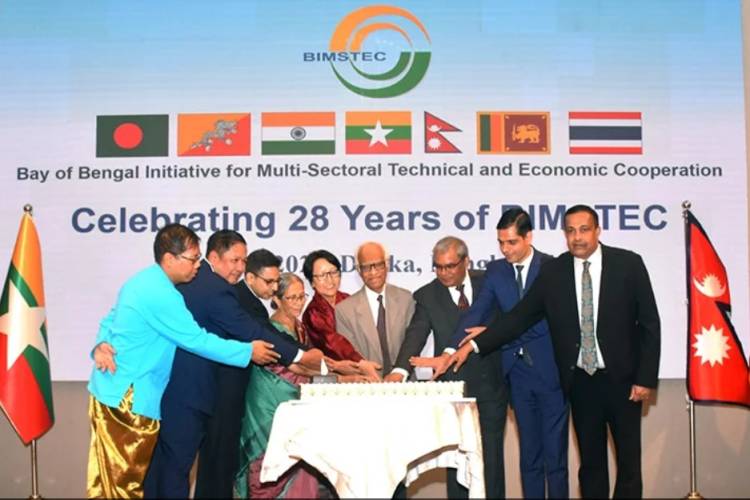
India’s intensified engagement with the Bay of Bengal Initiative for Multi-Sectoral Technical and Economic Cooperation signals a renewed commitment to regionalism —one rooted in connectivity, economic cooperation, and shared prosperity. As the grouping repositions itself as a bridge between South and Southeast Asia, India has emerged as the principal architect of BIMSTEC’s evolving 3C agenda: Connect, Collaborate, Consolidate.
While New Delhi’s diplomatic engagement with BIMSTEC is grounded in hard infrastructure, digital networks, energy integration, and institutional leadership. The recently concluded 6th BIMSTEC Summit in Bangkok underlined this shift from aspirational statements to operational frameworks.
READ | India’s urban housing crisis is a ticking time bomb
BIMSTEC – Connectivity as strategy
India’s emphasis on physical connectivity is at the heart of its regional diplomacy. The BIMSTEC Master Plan for Transport Connectivity (2022–2028), developed largely with Indian technical inputs and financial backing, outlines 264 projects worth over $120 billion. These span highways, ports, railways, and inland waterways—essentially an integrated regional mobility architecture.
The India-Myanmar-Thailand Trilateral Highway is one such flagship initiative. India has also welcomed international partnerships, with Japan committing nearly $2 billion to key infrastructure assets like the Matarbari Port, the Chittagong-Sabroom road link, and the Kaladan multimodal project. India’s operational control over Myanmar’s Sittwe Port reflects a strategic shift towards securing maritime logistics across the Bay.
Digital, energy, and knowledge linkages
India is steadily building a digital bridge across the BIMSTEC region. Optical fibre extensions and satellite capacity have been extended to Sri Lanka and the Maldives, with plans underway for similar initiatives in Nepal and Bhutan. The National Knowledge Network (NKN), India’s high-speed digital academic backbone, is now accessible to research institutions across BIMSTEC, enabling smoother academic and e-governance collaboration.
In the energy domain, India leads the effort to establish a BIMSTEC Grid Interconnection. Its broader “One Sun, One World, One Grid” vision is already manifest in projects linking Bhutan, Nepal, and Bangladesh to Indian electricity markets. An underwater cable connecting the Andaman Islands to Singapore is on the drawing board—intended to synchronise renewable energy flows across time zones and regions.
Regional security, capacity building and institutional depth
India currently leads four of BIMSTEC’s seven restructured sectors: counterterrorism and transnational crime, transport and connectivity, space cooperation, and security including disaster management. It has backed this leadership with regular disaster response exercises hosted by its defence forces, capacity-building under the Indian Technical and Economic Cooperation (ITEC) programme, and training offered by the Sushma Swaraj Institute of Foreign Service.
Security engagement has also moved beyond traditional defence. India is pushing for harmonised approaches to disaster resilience, cyber-security, and maritime threats. These institutional linkages are slowly embedding BIMSTEC as a credible regional platform rather than a diplomatic talking shop.
Trade, finance, and economic integration
India’s support for a BIMSTEC Free Trade Agreement (FTA) reflects its ambition to anchor a rule-based economic framework in the region. New Delhi has advanced trade facilitation measures, including customs digitisation and fintech innovations aimed at easing cross-border flows for smaller economies like Bhutan, Nepal, and Myanmar.
The proposal for a BIMSTEC Development Fund illustrates India’s intention to go beyond aid and grants and build a sustainable financial mechanism that can catalyse long-term regional projects. This complements India’s broader pitch for sustainable tax regimes and institutional reform.
Humanitarian engagement and health cooperation
India’s leadership has also been visible in public health and humanitarian assistance. The “Maitri Vaccine” initiative during the COVID-19 pandemic, earthquake relief operations (such as Operation Brahma), and liberalised medical visa regimes are examples of how India projects soft power through timely and generous regional support.
This multidimensional engagement reinforces India’s role as a regional responder, not merely a convenor. It blends humanitarian responsibility with geopolitical strategy—a hallmark of India’s evolving neighbourhood policy.
Blue economy and maritime governance
The Bangkok Vision 2030 declaration provides an opening to institutionalise cooperation in emerging sectors. Chief among them is the blue economy. India has pushed for joint exploration of deep-sea resources, including hydrocarbons and critical minerals, under the UNCLOS framework. New Delhi’s initiative to extend its maritime zone is not about exclusive control but about co-developing marine assets with regional partners.
This vision aligns well with India’s broader maritime strategy under “Neighbourhood First” and “Act East.” It seeks to uphold freedom of navigation, enforce a rules-based maritime order, and combat threats such as piracy and marine terrorism—linking BIMSTEC with other strategic groupings like the Quad, IORA, ASEAN, and the Indo-Pacific Oceans Initiative.
Toward institutional consolidation
India is now looking to consolidate BIMSTEC’s legal identity, moving the bloc from a consultative format to a more formalised regional institution with binding commitments. The scope also includes cooperation in emerging domains such as the start-up ecosystem, technology transfer, cyber governance, and knowledge economy.
Trilateral and multilateral engagements in these sectors—particularly involving BIMSTEC members—are already visible in India’s outreach efforts. From digital public infrastructure to maritime surveillance, the architecture of cooperation is gradually acquiring both scale and depth.
India’s leadership in BIMSTEC is not an assertion of dominance but a vision of collective stewardship of the Bay of Bengal. Through diplomatic persistence, financial commitment, and a calibrated approach to regional integration, India has shifted the narrative—from geography to strategy, from slogans to execution.
As the region prepares to operationalise the Bangkok Vision 2030, India’s challenge will be to sustain momentum, ensure equitable benefits, and reinforce BIMSTEC as a platform for inclusive development—not just for South and Southeast Asia, but as a model for regionalism in the Global South.
Dr Ram Singh is Professor and Head, Indian Institute of Foreign Trade, New Delhi. Views are personal.
